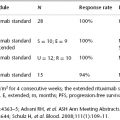Hereditary Breast Cancer Syndromes
1Dana-Farber Cancer Institute, Boston, MA, USA
2Ambry Genetics, Boston, MA, USA
Multiple Choice Questions
1. Hereditary breast-ovarian cancer syndrome is associated with germline mutations in which of the following two genes?
- MSH2 and MSH6
- BRCA1 and BRCA2
- BRCA2 and TP53
- BRCA1 and PTEN
Hereditary breast-ovarian cancer syndrome is associated with germline mutations in the BRCA1 and BRCA2 genes.
BRCA1 and BRCA2 mutations are identified in about 15–20% of individuals with family histories of breast cancer and about 60–80% of those with family histories of breast and ovarian cancers. Therefore, BRCA mutations are, by far, the most frequent cause of hereditary breast and ovarian cancers. Keep in mind that the majority of breast and ovarian cancers (90–95%) are not hereditary (i.e., not due to an underlying inherited gene mutation).
In the general population, it is estimated that 1 in 800 individuals carry a BRCA mutation. Among individuals of Eastern European (Ashkenazi) Jewish descent, about 1 in 50 individuals carry one of three specific mutations in the BRCA genes. The three Ashkenazi Jewish BRCA founder mutations are the 187delAG and 5385insC mutations in the BRCA1 gene and the 6174delT mutation in the BRCA2 gene. BRCA mutations have been identified in every ethnic group, and founder mutations have been identified in several other ethnic groups, including the Dutch, Icelanders, and French-Canadians.
2. What are the four major types of cancer associated with BRCA1 and BRCA2 mutations?
- Breast, uterine, colon, and prostate cancers
- Breast, ovarian, colon, and prostate cancers
- Breast, uterine, pancreatic, and colon cancers
- Breast, ovarian, pancreatic, and prostate cancers
The four major forms of cancer associated with BRCA1 and BRCA2 mutations are cancers of the breast, ovary, pancreas, and prostate. Women with BRCA mutations are at risk for developing breast cancer, often at younger-than-average ages. The risk of contralateral breast cancer is also increased. Women with BRCA1 mutations have an estimated 57–65% risk of breast cancer to age 70 and a 90% risk of breast cancer to age 80. Women with BRCA2 mutations have an estimated 41–49% risk of breast cancer to age 70. When compared with sporadic breast cancers, BRCA1-associated breast cancers are more likely to be medullary, to be of a higher grade, and to be “triple-negative” tumors (i.e., negative for estrogen receptors, progesterone receptors, and the Her2neu growth factor). BRCA2-associated breast cancers do not appear to have a specific phenotype.
Women with BRCA1 mutations have an estimated 24–40% risk of ovarian cancer. Women with BRCA2 mutations have an estimated 11–18% risk of ovarian cancer. BRCA-associated ovarian cancers are more likely to be serous adenocarcinomas. Women with BRCA mutations also have increased risks of fallopian tube and primary peritoneal cancers.
Men with BRCA mutations have an increased risk of prostate cancer. The relative risks for prostate cancer are 1.8 for men with BRCA1 mutations and 4.6 for men with BRCA2 mutations. When compared to sporadic prostate cancers, BRCA2-associated prostate cancers may occur at younger-than-usual ages and may have a more aggressive phenotype. Men with BRCA2 mutations also have a 6% risk of breast cancer. Breast cancers have also been reported in men with BRCA1 mutations.
Men and women with BRCA2 mutations may have as high as a 10% risk of developing pancreatic cancer. Cases of pancreatic cancer have also been reported in people with BRCA1 mutations.
3. All of the following features increase the likelihood of a BRCA mutation EXCEPT:
- Family history of pancreatic cancer
- Triple-negative breast tumor
- Lobular carcinoma in situ
- Ashkenazi Jewish heritage
Lobular carcinoma in situ (LCIS) is not a feature of Hereditary Breast-Ovarian Cancer syndrome. The presence of LCIS does not increase the likelihood of a BRCA mutation. In contrast, ductal carcinoma in situ (DCIS) is a feature of hereditary breast-ovarian cancer syndrome. However, the likelihood of a BRCA mutation in women with DCIS is lower than for women with invasive breast cancers.
Indications for BRCA genetic counseling and testing include the following:
- Women with premenopausal breast cancer, typically before age 50
- Women with triple-negative breast cancer diagnosed at any age
- Women with serous ovarian cancers, fallopian tube cancers, or primary peritoneal cancers, diagnosed at any age
- Women who have developed bilateral breast cancer or have developed two separate malignancies (e.g., breast and ovarian cancers, or breast and pancreatic cancers)
- Men with breast cancer diagnosed at any age
- Men with prostate cancers that have an aggressive phenotype and have occurred at a younger-than-usual age (typically under age 55)
- Individuals with pancreatic cancer who also have a family history of breast, ovarian, prostate, or pancreatic cancer
- Individuals who are cancer-free but have family histories that include any of the cancers listed above
- Individuals of Ashkenazi Jewish heritage who have any personal or family history of breast, ovarian, and/or pancreatic cancers diagnosed at any age.
Several empiric risk models have been developed to help calculate the likelihood that an individual carries a BRCA mutation. These models base their calculations on the number of breast and ovarian cancers among the patient and his or her first- and second-degree relatives, as well as the ages at diagnosis and the family’s ethnicity (Ashkenazi Jewish or not). The most widely used models for BRCA estimation are BRCAPRO and Myriad II.







